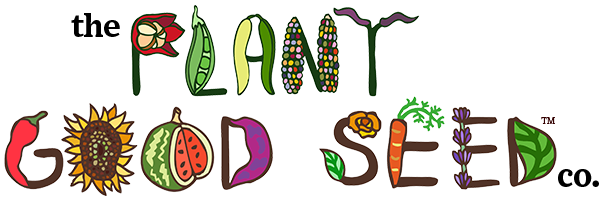“Negreta,” a fava (Vicia faba) variety originating from either Italy or Spain, yields large green pods with large beans that mature to a dark, imperial purple shade. The beans are not only visually striking; they also mature up to 10 days faster than the Broad Windsor.
Seeds are certified organic.
“Negreta,” a fava (Vicia faba) variety originating from either Italy or Spain, yields large green pods with large beans that mature to a dark, imperial purple shade. The beans are not only visually striking; they also mature up to 10 days faster than the Broad Windsor.
Seeds are certified organic.
I first became interested in fava beans (Vicia faba) when I saw them happily growing between the cracks of some stone pavers in Quin’s yard during a winter visit to Ojai - any food plant that volunteers without irrigation in Southern California is worth further examination in my book. Quin gave me a pile of beans from a bucket of “off-types” and this was my entry into the world of fava.
Favas, also sometimes called broad beans, are considered one of the oldest domesticated legumes, with earliest evidence of cultivation taking place more than 10,000 years ago in the Southern Levant. They have a higher protein content than most other pulses, and are a very common food to this day across the SWANA and Mediterranean regions. Although their use and cultivation is less widespread in North America, their food value and their high capacity for nitrogen fixing as a cover crop has led to much bioprospecting research into fava as a dominant crop of the future. On a more approachable scale, smaller ecologically minded growers on this continent have long recognized the value of this plant, and therefore there are a handful of interesting and distinct varieties available to work with.
Although you don’t need to soak favas before planting, I find it easier to do this step than to keep them adequately moist to germinate once in the ground. Larger beans like favas require a soaking time of 48-72 hours. Carol Deppe describes this process with nuance in The Resilient Gardener, but the basic gist is that you want to keep an eye on the soaking beans - change out the water at least once a day rinsing the beans to make sure you don’t get undesirable bacterial growth. Observe the beans - they will be ideally ready to plant when you can see the root tip (the radicle) about to emerge from beneath the now more translucent seed coat. Any bad seed will float to the top and you can eliminate it. This process not only speeds up germination but also lets you in on a part of seed development that usually happens invisibly underground.
Even though it is interesting and kind of fun, many people eschew the soaking process and plant dry beans directly into the ground, especially if they are working with larger quantities. There is some disagreement in the literature about optimal germination temperatures for favas, with citations ranging everywhere from 42-70˚F. Here in the mid-Atlantic I have had luck growing it on a schedule similar to peas - planting well before last frost in early March and harvesting beans by June. Whenever you choose to plant, do so at a depth of about 1” and be gentle so you don’t damage the emerging radicals if you did pre-soak.
Higher temperatures will inhibit growth and yields, so this is definitely a cool season crop anywhere that has hot summers. Although I have personally not experimented with fall sowing, favas are frost hardy to an extent, and there are varieties that can survive various ranges of freezing temperatures. If you live somewhere with mild-to-medium-cold winters and want to seed favas in the fall to harvest in the spring, this might be worth investigation and some trials!
Favas have an upright bushy growth habit, and most common varieties offer a stunningly unusual coloration of a white flower with a black spot. The beans can be harvested as a fresh shelling bean when the pods are plump, hard, and shiny bright green; or as a dry storage bean when the pods are brown, dry and crunchy. I hear that the shoots of the plants are tasty as well, and that when harvested very young, the beans can be eaten with their pod as a green bean. My own experiments with the latter have led to some hairy and fibrous chewing, so it seems like catching it at the perfect moment for the “green bean” stage is an art to develop over time.
If you are growing favas as a cover crop, for best results you are encouraged to mow down the crop right after it begins flowering and leave the cuttings to rot in place - this will keep the maximum amount of fixed nitrogen in the soil, instead of it being expended again in the plant’s formation of its seed.
Collections: All Products Beans Fava Beans
We use cookies on our website to give you the very best shopping experience we can. By using this site, you agree to its use of cookies.
Emails every 4-6 weeks featuring compelling original gardening content, new variety announcements, sales, and event appearances.
